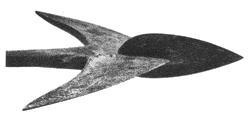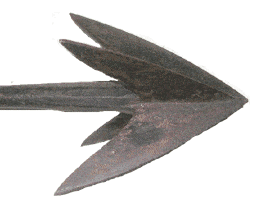
In an effort to solve the problem of approaching a whale close enough to dart a harpoon into it, especially in the ice of the Arctic whale fisheries, it was thought that a harpoon fired from a gun would be the answer. There were may trials with a large swivel gun mounted in the bow of the whaleboat, but excessive recoil transmitted to the light-weight boat proved to be a problem. Therefore, a shoulder gun to fire a harpoon was tried. These harpoons had to be a light weight to reduce the recoil of the gun to a point where it could be endured by the man firing the gun. This proved to be a harpoon of approximately 3 lbs. `Some shoulder gun harpoons and bombs could only be used in one particular gun, such as the Robert Brown gun and harpoon. These are presented with the gun in which they were used (see the page for Shoulder Guns for these irons).
Bomb lances were introduced with shoulder guns to address the issue of getting close enough to a whale to lance it, particularly in ice fields, and to eliminate the often hazardous lancing operation. While there were many variations of bomb lances, only the most widely used designs will be discussed here. A complete list of patented bomb lances is provided on the patents page.
The shoulder gun harpoons and bombs presented here could be fired from any gun with a compatible bore. For the most part, this was the Brand gun, which was manufactured in three different bores. Some other guns could be used as well, such as the Grudchos and Eggers shoulder gun with a smooth bore.

The first successful shoulder gun was the Brand Gun, introduced by Oliver Allen of Norwich, Connecticut, in 1846 (see Shoulder Guns for a description of this gun). The gun fired either a bomb lance or a harpoon, both patented by Oliver Allen. The bomb lance was the first of its kind, patented in 1846 (U.S. Patent No. 4,764, Sept. 19, 1846). This bomb consisted of a two-edged cutting blade screwed into a brass bomb shell mounted on a long fuse tube. The rear part of the fuse tube was made of a hollow wood shaft to fit the bore of the muzzle-loaded gun, 7/8" bore. The fuse was ignited by the flash of the gunpowder when the gun was discharged. This bomb lance was called the "Broomstick Lance" because of its long wood shaft. It had one major problem: it did not fly in a straight trajectory but tended to hit the whale broadside, flipping end-over-end in flight.
Oliver Allen, also from Norwich, Conn., patented a shoulder-gun harpoon in 1848 (U.S. Patent No. 5949, Dec. 5, 1848). Allen's patent focused on a method to improve accuracy in flight by minimizing the effect of the attached whale line. He believed the point of attachment of the line was crucial and should not be done by means of a sliding ring, as was the case for swivel gun harpoons like the Greener gun irons. He also felt the line should not be attached to the butt end of the iron to trail behind. In his patent specifications, Allen stated:
"It is exceedingly difficult, if not absolutely impossible, to shoot a harpoon from a gun with accuracy when the line is appended to it by such a sliding swivel, or is attached to the rear of the instrument. It must be fastened at or near the middle of the harpoon, in order to have the harpoon advance in a straight or nearly straight course. This I have demonstrated after long experience and many experiments."
Oliver Allen's gun harpoon was composed of a forward section, which included the head, shank, and a socket, and a rear section, which was a lightweight shaft designed to fit into the gun barrel. The socket was constructed as a short tube with a wide, flat shoulder at its forward end, unlike the typical socket of a hand harpoon. The whale line was tied around the shank in the usual manner and rested against the wide shoulder of the socket. The lightweight rear part of the harpoon, which fit into the gun's bore, contained the fuse and did not need to withstand the pull of a running whale.
There were three versions of this lightweight rear shaft. The earliest version was a wood shaft made in two longitudinal halves, secured together by light line wrapped around them, about 5 to 6 inches back from the forward end. A metal ferrule was crimped around the butt end to prevent the wood from shattering due to the gun's explosion and to further secure the two halves. A cork and leather button were screwed to the butt to act as a wad for a tight fit in the barrel. The second version had a cross-section resembling a plus sign (+). Its butt end featured a solid metal disk that acted as the powder wad. The third version consisted of a shaft made of thin-wall iron tubing closed at the butt end with a plug.
 The head configuration of the Allen harpoon was initially made as a two-flue iron with a lance blade set into a slot at the tip of the head, positioned at a right angle, and projecting slightly beyond it. This blade might have been intended to serve as an aerodynamic stabilization fin, as it had no other practical purpose. This feature is not found on hand-darted harpoons but is present on other early gun harpoons from around 1850, particularly in the New London, Connecticut area.
The head configuration of the Allen harpoon was initially made as a two-flue iron with a lance blade set into a slot at the tip of the head, positioned at a right angle, and projecting slightly beyond it. This blade might have been intended to serve as an aerodynamic stabilization fin, as it had no other practical purpose. This feature is not found on hand-darted harpoons but is present on other early gun harpoons from around 1850, particularly in the New London, Connecticut area.
Early Oliver
Allen gun harpoon head configuration.
The head configuration of the Oliver Allen gun harpoon was not patented. Later, the head was changed to the more familiar four-flue design, as depicted in the patent drawing. This design resembled two two-flue heads joined perpendicularly, with one projecting about 3/8 inch beyond the other, likely to facilitate sharpening. This configuration has been referred to as a clover-leaf harpoon and sometimes as the Orange iron.

